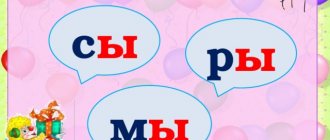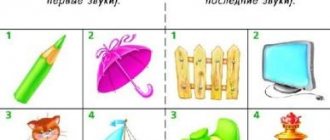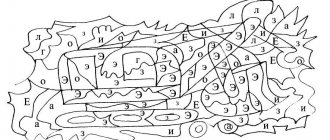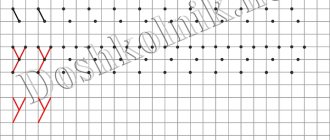Pelykh N.I., teacher-speech therapist, preschool educational institution No. 1410, Moscow
OBJECTIVES OF THE LESSON Comparison, discrimination and correct pronunciation of sounds [t] and [d] in syllables, words, phrases, stories. Development of logical thinking, attention, memory, phonemic hearing. Sound analysis and synthesis of one-syllable, two-syllable and three-syllable words based on the sound-syllable scheme of words and sentences. Distinguishing between paronymous words. Formation of polysyllabic words. Development of visual gnosis when composing a story based on supporting silhouette pictures using prefixed verbs. PREPARATION The following materials are prepared: - object pictures for the sounds [t] - [d]; - typesetting canvas; — flannelograph; - diagrams of words, sentences; - symbols of sounds; — plot pictures; - bear cub - bi-ba-bo toy; - screen. * * * Organizational moment There is a knock on the door. Speech therapist. Who's there? (Pulls out a bear cub from behind the screen.) Bear cub. It’s me, little bear, who came to visit you. Hello. Guys, did you receive my letter yesterday? Did you like my pictures? And today I have prepared riddles for you. The lanky man walked, got stuck in the damp ground. Largely, little by little, watered the whole earth with water. (Rain.) He bows, he bows, When he comes home he will stretch out. (Axe.) A white pillar stands on the roof And grows higher and higher, Now it has grown to the skies And disappeared. (Smoke.) Fluffy cotton wool floats somewhere. The lower the cotton wool, the closer the rain. (Cloud.) Children solve riddles. The little bear praises them and says goodbye. Comparison of sounds [t] - [d] Children sitting in the right row are asked to pronounce the sound [t], in the left - the sound [d], holding their hand on their throat. Speech therapist. How are the sounds similar? Children. The tongue knocks on the upper teeth, the lips smile, they are both consonant and firm. Speech therapist. What is the difference? Children. The sound [t] is deaf, and the sound [d] is voiced, we pronounce it with a voice. Differentiation of sounds [t] - [d] in syllables Didactic ball game “Say the other way around” Children are asked to stand in a circle. The task is given to come up with a syllable with the opposite sound. The speech therapist throws the ball to the child and pronounces the syllable “ta”; the child, returning the ball to the speech therapist, must say “yes” (“et” - “ed”, “you” - “dy”, etc.). Differentiation of sounds [t] – [d] in paronymous words Didactic game “Find a Pair” The typesetting canvas depicts a boy Tolya and a girl Dasha. Children are given the task of putting pictures with the sound [t] - Tole, and with the sound [d] - Dasha. The speech therapist pronounces sentences, and the children must name the last word that matches the meaning, find a picture and put it on the typesetting canvas. Speech therapist Let's call the book... (volume). We will build... (house) for housing. Here is a cart, this is... (wheelbarrow). The house in the garden is called... (dacha). They are floating along the river... (rafts). Ripening on the branches... (fruits). Etc. Sound analysis and synthesis of words Didactic exercise “Match the word to the diagram” Four schemes of words are depicted on the board, and on the children’s tables there are pictures depicting objects whose names contain the sounds [t] - [d]. Children are given the task of putting their pictures on the diagrams in accordance with the sound content of the word and explaining their choice. One-syllable words Smoke, shower, cat, house One-syllable words with a combination of consonants at the end Cake, tank, umbrella, bow Two-syllable words made of two open syllables Cotton wool, notes, melon, houses Three-syllable words made of open syllables Shovel, road, rainbow, car Physical education to the music, children pronounce a simple phrase and perform the corresponding movements. Children A woodpecker is hollowing out a tree, A woodpecker is hollowing out an oak tree with its beak. Knock-knock-knock, knock-knock-knock, he's looking for the worm here. Formation of polysyllabic words and development of phonemic hearing There are images of a girl and a cat on the flannelgraph. Speech therapist. What kind of hair does the girl have? Children. Blonde hair. Speech therapist. I lay out two stripes that indicate the number of words. Which girl? Say it in one word. Children. Blonde. In this case, on the flannelgraph, two short strips are combined into one long one. Speech therapist. What kind of ears does a cat have? Children. Short ears. Speech therapist. What cat? Say it in one word. Children. Short-eared. In parallel, children work with symbols. There are two cards on the tables: one empty (symbolizing a dull sound), and the other with the image of a bell (symbolizing a ringing sound). Children pick up one or the other card depending on what sound (voiced [d] or unvoiced [t]) they heard in the named words. Working on a sentence diagram One child lays out a sentence diagram on a flannelgraph, and the rest on the tables. A blonde girl plays with a short-eared cat. Differentiation of sounds [t] - [d] Story based on reference silhouette pictures “Tolya at the dacha” In the summer, Tolya rested at the dacha. He went to the river to catch fish with a fishing rod. Tolya got into the boat and sailed away from the shore. Sailed past the island. He swam across the river and swam to the other bank. He caught a lot of fish with his fishing rod and sailed home. Children retell the story first in a chain, and then in its entirety. At the end of the lesson, its conclusion is summed up. In order for a child to learn sound speech, the following conditions must be met. 1. First of all, the child’s speech apparatus must be in good working order; Each department must work correctly and in full harmony with the other departments. 2. The child must have good hearing. 3. Through this hearing he must perceive good examples of speech offered to him by those around him. 4. The child must be so mentally developed that he generally has something to talk about. 5. In the absence of at least one of these conditions, we are dealing with speech disorders or deficiencies.








